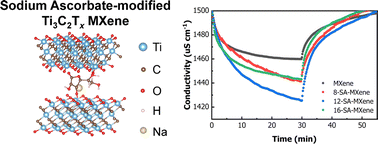Themed collection Design and characterization of flexible electrode materials

Advancing low-dimensional flexible energy devices for wearable technology
This perspective article discusses the research, issues, and prospects of flexible batteries and supercapacitors in terms of one- and two-dimensions, as well as their stretchable, bendable, and twistable properties.

J. Mater. Chem. A, 2024, Advance Article
https://doi.org/10.1039/D4TA02241F
Flexible resistive tactile pressure sensors
This review covers recent advancements in flexible resistive tactile pressure sensors, including operational principles, performance metrics, material choices, structural design, and applications, as well as future challenges.

J. Mater. Chem. A, 2024,12, 9296-9321
https://doi.org/10.1039/D3TA06976A
Recent progress in polyaniline-based chemiresistive flexible gas sensors: design, nanostructures, and composite materials
An overview of nanostructured PANI gas sensors and chemiresistive or heterojunction-based PANI composite gas sensors.

J. Mater. Chem. A, 2024,12, 6190-6210
https://doi.org/10.1039/D3TA07687C
Foldable chromium vanadate cathodes for high-performance aqueous zinc ion batteries
A novel cathode material, CrV2.7O4.36·2.85H2O/CNT-rGO, composited with a CNT and rGO framework was developed. The flexible battery assembled with it still has stable electrochemical performance under different folding states.

J. Mater. Chem. A, 2024,12, 10764-10772
https://doi.org/10.1039/D3TA08078A
Highly stretchable GR/TPU strain sensor based on one-step electrospun fibrous yarns for wearable devices
A highly stretchable GR/TPU strain sensor is fabricated based on one-step electrospun fibrous yarns for wearable devices.

J. Mater. Chem. A, 2024,12, 10905-10912
https://doi.org/10.1039/D4TA00176A
A “two-birds-one-stone” strategy to enhance capacitive deionization performance of flexible Ti3C2Tx MXene film electrodes by surface modification
A dual-function strategy is proposed that uses sodium ascorbate to modify Ti3C2Tx MXene for flexible and free-standing electrodes for capacitive deionization, enhancing its oxidation resistance and salt adsorption capacity.

J. Mater. Chem. A, 2024,12, 8734-8746
https://doi.org/10.1039/D4TA00236A
Cobalt-based current collectors for flexible electrodes and their application in lithium–sulfur batteries
A Co-based current collector with high conductivity and light weight can improve the conductivity and battery performance of flexible electrodes.

J. Mater. Chem. A, 2024,12, 5760-5767
https://doi.org/10.1039/D3TA06966D
CoP/CoN heterostructural active centers supported on nitrogen carbon nanorod arrays as freestanding high-performance trifunctional electrocatalysts
Freestanding CoP/CoN heterostructure electrocatalysts for zinc–air batteries and water splitting, and the catalytic mechanism was verified based on DFT and experiments.

J. Mater. Chem. A, 2024,12, 3997-4007
https://doi.org/10.1039/D3TA06935D
Multi-mode mechanoluminescence of fluoride glass ceramics from rigid to flexible media toward multi-scene mechanical sensors
First time dual-mode mechanoluminescence in fluoride glass ceramics, transitioning from rigid to flexible media for versatile mechanical sensing.

J. Mater. Chem. A, 2024,12, 2796-2806
https://doi.org/10.1039/D3TA06257K
High-rate and long-life flexible aqueous rechargeable zinc-ion battery enabled by hierarchical core–shell heterostructures
TiN can optimize the conductivity of MnO2, while reducing Zn2+ diffusion barrier and improve the rate performance. The lower formation energy of Zn2+ insertion endows a capacity retention of 101.6% over 2300 cycles for the TiN@MnO2 NWAs/CC.

J. Mater. Chem. A, 2024,12, 2172-2183
https://doi.org/10.1039/D3TA06183C
About this collection
The design and characterization of flexible electrode materials, situated at the confluence of materials chemistry and engineering, holds pivotal significance for society. Through tailoring composition, structure, and mechanical properties, these materials optimize performance and adaptability in flexible electronics. This bears remarkable implications: from wearable health monitors to sustainable energy solutions. The historical trajectory highlights an evolution from rigid electrodes to innovative materials like conductive polymers, carbon nanotubes, and graphene. This progression, propelled by a nuanced understanding of materials chemistry, enables precise manipulation of materials properties.
The field's connection with materials chemistry lies in its ability to engineer molecular structures, surface attributes, and interfacial interactions to fine-tune conductivity, electrochemical performance, and mechanical resilience. This harmony between chemistry and engineering ensures materials not only exhibit exceptional traits but also endure real-world demands. This dynamic interplay of science and engineering catalyses wearable tech, energy storage, and beyond, showcasing the transformative potential of materials chemistry in reshaping technology and enhancing human life.
This themed collection of Journal of Materials Chemistry A, Guest Edited by Professor Xiu Song (George) Zhao (Qingdao University, China), Professor Hui Ying Yang (Singapore University of Technology and Design, Singapore) and Professor Li Qiang (Qingdao University, China), aims to provide a platform for recent developments in this field of design and characterization of flexible electrode materials. We hope that readers find this themed collection informative and useful.